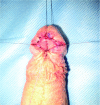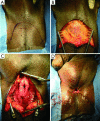The contemporary management of urethral strictures in men resulting from lichen sclerosus
- PMID: 26816805
- PMCID: PMC4708274
- DOI: 10.3978/j.issn.2223-4683.2015.01.08
The contemporary management of urethral strictures in men resulting from lichen sclerosus
Abstract
Lichen sclerosus (LS) is a chronic, inflammatory disease primarily involving the genital skin and urethra in males. Historically, the treatment of this common condition was a challenge due to its uncertain etiology, variable response to therapy, and predilection to recur. The etiology of LS is still debated and has been linked to autoimmune disease, infection, trauma, and genetics. Today, topical steroids are a mainstay of therapy for patients, even in the presence of advanced disease, and can induce regression of the disease. In advanced cases, surgery may be required and range from circumcision, meatoplasty, or, in the case of advanced stricture disease, urethroplasty or perineal urethrostomy. When urethroplasty is required, the use of genital skin as a graft or flap is to be avoided due to the predilection for recurrence. Surgical management should be approached only after failure of more conservative measures due to the high risk of recurrence of LS in the repaired site despite the use of buccal grafting. LS may be associated with the development of squamous cell carcinoma and for this reason, patients should undergo biopsy when LS is suspected and long-term surveillance is recommended.
Keywords: Lichen sclerosus (LS); urethral strictures; urethroplasty.
Conflict of interest statement
Figures





References
-
- Powell JJ, Wojnarowska F. Lichen sclerosus. Lancet 1999;353:1777-83. - PubMed
-
- New nomenclature for vulvar disease. Obstet Gynecol 1976;47:122-4. - PubMed
-
- Kulkarni SB, Joshi PM, Venkatesan K. Management of panurethral stricture disease in India. J Urol 2012;188:824-30. - PubMed
-
- Barbagli G, Mirri F, Gallucci M, et al. Histological evidence of urethral involvement in male patients with genital lichen sclerosus: a preliminary report. J Urol 2011;185:2171-6. - PubMed
-
- Oyama N, Chan I, Neill SM, et al. Autoantibodies to extracellular matrix protein 1 in lichen sclerosus. Lancet 2003;362:118-23. - PubMed
Publication types
LinkOut - more resources
Full Text Sources
